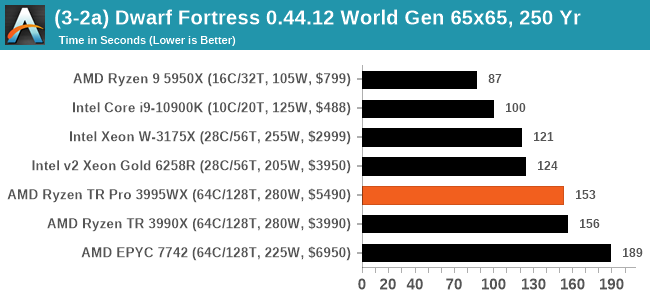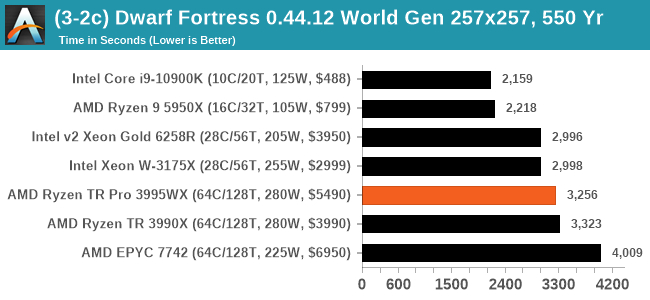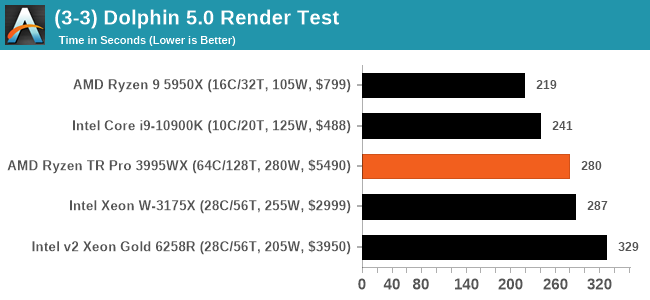64 Cores of Rendering Madness: The AMD Threadripper Pro 3995WX Review
by Dr. Ian Cutress on February 9, 2021 9:00 AM EST- Posted in
- CPUs
- AMD
- Lenovo
- ThinkStation
- Threadripper Pro
- WRX80
- 3995WX
CPU Tests: Simulation
Simulation and Science have a lot of overlap in the benchmarking world, however for this distinction we’re separating into two segments mostly based on the utility of the resulting data. The benchmarks that fall under Science have a distinct use for the data they output – in our Simulation section, these act more like synthetics but at some level are still trying to simulate a given environment.
DigiCortex v1.35: link
DigiCortex is a pet project for the visualization of neuron and synapse activity in the brain. The software comes with a variety of benchmark modes, and we take the small benchmark which runs a 32k neuron/1.8B synapse simulation, similar to a small slug.
The results on the output are given as a fraction of whether the system can simulate in real-time, so anything above a value of one is suitable for real-time work. The benchmark offers a 'no firing synapse' mode, which in essence detects DRAM and bus speed, however we take the firing mode which adds CPU work with every firing.
The software originally shipped with a benchmark that recorded the first few cycles and output a result. So while fast multi-threaded processors this made the benchmark last less than a few seconds, slow dual-core processors could be running for almost an hour. There is also the issue of DigiCortex starting with a base neuron/synapse map in ‘off mode’, giving a high result in the first few cycles as none of the nodes are currently active. We found that the performance settles down into a steady state after a while (when the model is actively in use), so we asked the author to allow for a ‘warm-up’ phase and for the benchmark to be the average over a second sample time.
For our test, we give the benchmark 20000 cycles to warm up and then take the data over the next 10000 cycles seconds for the test – on a modern processor this takes 30 seconds and 150 seconds respectively. This is then repeated a minimum of 10 times, with the first three results rejected. Results are shown as a multiple of real-time calculation.

This test prefers monolithic silicon with proportionally lots of memory bandwidth, which means that we get somewhat of an equalling of results here. The top result in our benchmark database is actually single chiplet Ryzen.
Dwarf Fortress 0.44.12: Link
Another long standing request for our benchmark suite has been Dwarf Fortress, a popular management/roguelike indie video game, first launched in 2006 and still being regularly updated today, aiming for a Steam launch sometime in the future.
Emulating the ASCII interfaces of old, this title is a rather complex beast, which can generate environments subject to millennia of rule, famous faces, peasants, and key historical figures and events. The further you get into the game, depending on the size of the world, the slower it becomes as it has to simulate more famous people, more world events, and the natural way that humanoid creatures take over an environment. Like some kind of virus.
For our test we’re using DFMark. DFMark is a benchmark built by vorsgren on the Bay12Forums that gives two different modes built on DFHack: world generation and embark. These tests can be configured, but range anywhere from 3 minutes to several hours. After analyzing the test, we ended up going for three different world generation sizes:
- Small, a 65x65 world with 250 years, 10 civilizations and 4 megabeasts
- Medium, a 127x127 world with 550 years, 10 civilizations and 4 megabeasts
- Large, a 257x257 world with 550 years, 40 civilizations and 10 megabeasts
DFMark outputs the time to run any given test, so this is what we use for the output. We loop the small test for as many times possible in 10 minutes, the medium test for as many times in 30 minutes, and the large test for as many times in an hour.



Dwarf Fortress is mainly single-thread limiting, hence the 64-core models at the back end of the queue. The TR parts are still a good bit faster than the EPYC.
Dolphin v5.0 Emulation: Link
Many emulators are often bound by single thread CPU performance, and general reports tended to suggest that Haswell provided a significant boost to emulator performance. This benchmark runs a Wii program that ray traces a complex 3D scene inside the Dolphin Wii emulator. Performance on this benchmark is a good proxy of the speed of Dolphin CPU emulation, which is an intensive single core task using most aspects of a CPU. Results are given in seconds, where the Wii itself scores 1051 seconds.

Similarly here, single thread performance matters.












118 Comments
View All Comments
YB1064 - Tuesday, February 9, 2021 - link
You are kidding, right? Intel has become the poor man's AMD in terms of performance.kgardas - Wednesday, February 10, 2021 - link
From general computing point of view yes, but from specific point no. Look at 3d particle movement! 3175x with less than half cores, at least $1k cheaper is able to provide more than 2x perf of the best AMD. So if you have something hand optimized for avx512, then old, outdated intel is still able to kicks amd ass and quite with a style.Spunjji - Wednesday, February 10, 2021 - link
@kgardas - Sure, but not many people can just throw their code at one of only a handful of programmers in the world with that level of knowledge and get optimised code back. That particle movement test isn't an industry-standard thing - it's Ian's personal project, hand-tuned by an ex-Intel engineer. Actual tests using AVX512 aren't quite so impressive because they only ever use it for a fraction of their code.Fulljack - Thursday, February 11, 2021 - link
not to mention that any processor that run in avx512 will have it's clockspeed tanked. unless your program maximize the use of avx512, the net progress will result slower application than using avx/2 or none at all.sirky004 - Tuesday, February 9, 2021 - link
what's you deal with AVX 512?Usual workload with that in mind is better to offload in GPU.
There's a reason why Linus Torvald hate that "power virus"
kgardas - Wednesday, February 10, 2021 - link
Usually if you write the code, it's more easier to add few avx512 intrinsic calls then to rewrite the software for GPU offload. But yes, GPU will be faster *if* the perf is not killed by PCIe latency. E.g. you need to interact with data on CPU and perform just few calcs on GPU so moving data cpu -> gpu -> cpu -> loop over, will kill perf.kgardas - Wednesday, February 10, 2021 - link
AFAIK, Linus hates that avx512 is not available everywhere in x86 world. But this will be the same case with upcoming AMX, so there is nothing intel may do about it. Not sure if AMD will need to pay some money for avx512/amx license or not...Qasar - Wednesday, February 10, 2021 - link
sorry kgardas but linus HATES avx512:https://www.extremetech.com/computing/312673-linus...
https://www.phoronix.com/scan.php?page=news_item&a...
"I hope AVX512 dies a painful death, and that Intel starts fixing real problems instead of trying to create magic instructions to then create benchmarks that they can look good on… "
where you got that he likes it. and chances are, unless intel makes amx available with no issues, amx maybe the same niche as avx 512 is.
kgardas - Wednesday, February 10, 2021 - link
Yes, I know he hates the stuff, but not sure about the right reason. In fact I think AVX512 is best AVX so far ever. I've read some of his rants and it was more about avx512 is not everywhere like avx2 etc. etc. Also Linus was very vocal about his departure from Intel workstation to AMD and since AMD does not provide avx512 yet it may well be just pure engineering laziness -- don't bother me with this stuff, it does not run here. :-)Qasar - Wednesday, February 10, 2021 - link
i dont think it has to be do with laziness, it has to do with the overall hit you get in performance when you use it, not to mention the power usage, and the die space it needs. from what i have seen, it still seems to be a niche, and over all not worth it. it looks like amd could add avx512 to zen at some point, but maybe, amd has decided it isnt worth it ?